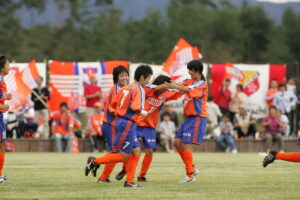“History of the Nadeshiko League” 13. “Birth of Division 2 and Nationwide Expansion”
From the time when it was still unusual for women to play football, through to the birth of the Japan Women’s Football League, victory in the Women’s World Cup, and creation of the Japan Women’s Empowerment Professional Football League, social conditions and the environment surrounding girls’ and women’s football have undergone great changes.
We intend to publish a series of 22 articles before the end of the year in which we will look back over the tempestuous history of girls’ and women’s football in Japan.

2004 was an unforgettable year for women’s football in Japan. Thanks to the exploits of the Japan women’s national team, the nickname of “Nadeshiko Japan” entered the vernacular, while the Japan Women’s Football League changes its name from the “L. League” to the “Nadeshiko League”. Moreover, the “L. League” finally adopted a second division in its 16th season.
The number of teams in the league dropped from 10 to eight in 1999, however, thanks to an increase in new applications for membership, the number recovered to nine teams in 2000, 10 teams in 2001, and 11 teams in 2002. In 2003, the number of teams increased to 13 with the additions of Ohara Gakuen JaSRA Women’s SC (Nagano Prefecture) and Okayama Yunogo Belle (Okayama Prefecture).
This trend continued with the addition of Albirex Niigata Ladies (Niigata Prefecture) for the 2004 season, when it was decided to operate two divisions comprising eight clubs in Division 1 and six clubs in Division 2.
However, this expansion of the league did not only signify an increase in the number of affiliated clubs. It was also a reflection of the fact that girls’ and women’s football had spread and become active all over Japan, literally growing into a nationwide sport.
Girls’ and women’s football in Japan following WWII started with the founding of clubs and playing of games in the Kansai (Osaka and Hyogo) and Kanto (Tokyo and Kanagawa) regions, and girls subsequently started playing in the “football kingdom” of Shizuoka Prefecture. When the first Japan Women’s Football League was launched in 1989, three out of the six member clubs were located in Tokyo, one was in Shizuoka Prefecture, one was in Mie Prefecture, and one was in Hyogo Prefecture, and this was indicative of the spread of girls’ and women’s football in Japan at that time.
When the league was expanded to 10 clubs in 1991, four new teams were added from the prefectures of Chiba, Kanagawa, Kyoto and Osaka, and these were followed by the addition of teams from Aichi Prefecture in 1993 and Saitama Prefecture in 1994. However, despite these new additions, there was no major change in the pattern of concentration in the area spanning Kanto and Kansai, and this remained the same in following years too.
The L. League eventually expanded into new areas with the addition of YKK Tohoku Ladies SC Flappers (Miyagi Prefecture) and Renaissance Football Club (Kumamoto Prefecture) in 2000. Moreover, with the addition of clubs from Nagano Prefecture and Okayama Prefecture in 2003 and Niigata Prefecture in 2004, the league had grown to include top teams in the metropolitan region and 10 other prefectures.
Football in Japan is organized into 47 prefectural football associations that conduct various activities divided into nine areas around the country. From north to south, these areas comprise Hokkaido (one association), Tohoku (six prefectural associations), Kanto (one metropolitan and seven prefectural associations), Hokushinetsu (five prefectural associations), Tokai (four prefectural associations), Kansai (six prefectural associations), Chugoku (five prefectural associations), Shikoku (four prefectural associations), and Kyushu (eight prefectural associations).
With the addition of Ohara Gakuen and Okayama Yunogo Belle in 2003, although there were still ups and downs, the number of prefectures having representation in Japan’s top women’s football league had risen to 14, comprising the Tokyo metropolitan area and 13 prefectures. In terms of regional spread, too, whereas the league had been concentrated into the three areas of Kanto, Tokai and Kansai for the first 11 seasons up to 1999, Tohoku and Kyushu were newly added in 2000, and they were joined by Hokushinetsu and Chugoku in 2003, which meant that seven out of nine areas in Japan now had top women’s football clubs.
After a little more time elapsed, Norddea Hokkaido (Hokkaido Prefecture) joined the league in 2010, followed by Ehime FC Ladies (Ehime Prefecture in Shikoku) in 2012. As a result, women’s football (including the Challenge League from 2010 onwards) had teams competing from all nine areas of Japan’s football structure. When viewed in terms of prefectures, a total of 24 prefectures had been represented by 2020, meaning that the Nadeshiko League had participation from the “majority” of Japan’s prefectures.
The objective of the Japan Women’s Football League at the time of its founding was to enable powerful teams to compete against each other and thereby strengthen the Japan national team. However, the attraction of the league stimulated girls’ and women’s football around Japan to such an extent that the footballing base was expanded and the number of clubs aspiring to reach the top increased all over the country. As a result, opportunities to watch high-level women’s football games spread throughout Japan.
The Nadeshiko League has played a vital role in the development of girls’ and women’s football in Japan. The fact that the trigger for that development coincided with the league’s toughest “period of crisis” conveys the powerful lifeforce of the women’s game in Japan.
Yoshiyuki Osumi (football journalist)






